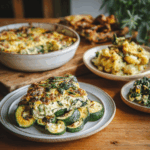Follow Me On Social Media!
Ricotta Cheese Filling for Lasagna: Classic, Creamy & Foolproof Layers
If you’re craving a lasagna that’s creamy, satisfying, and never dry, the secret’s in the filling—and ricotta cheese is your new best friend. In this article, you’ll discover how to make a foolproof ricotta cheese filling for lasagna, using ingredients you probably already have in your kitchen. We’ll also answer the most common questions people ask about ricotta in lasagna—from whether you need an egg to the right layering technique. Whether you’re a weekend home cook or planning Sunday dinner, this step-by-step guide is crafted to give you total confidence in your next bake. Let’s dive into the creamy center of one of Italy’s most beloved dishes.
A Southern Kitchen Story Meets Italian Comfort
The memory that sparked this recipe
I was around ten, standing on a wooden step stool in my grandmother’s Savannah kitchen, when I first tasted a spoonful of warm ricotta filling. She was making Sunday lasagna, and her voice still rings in my memory: “Good lasagna is all about the middle.” Back then, we used simple ingredients—ricotta, an egg, fresh parsley, and a handful of Parmesan. No frills, just flavor. That memory has traveled with me through decades of cooking, and it’s the inspiration for this simple, nourishing ricotta cheese filling for lasagna.
Today, I make this filling for family dinners or to layer into hearty meals like my chicken parmesan recipe or even paired with a side like garlic fries. The point is, this isn’t just cheese in a pan—it’s a taste of home, shared over a big casserole dish.
Why ricotta cheese is the heart of great lasagna
Using ricotta cheese in lasagna creates a lush, creamy layer that melts between the pasta and sauce. Unlike heavier béchamel sauces, ricotta offers a light, airy texture that complements marinara and meat beautifully. It’s the ingredient that balances the dish—not too rich, not too dry, but just right.
A traditional ricotta cheese filling for lasagna is also incredibly versatile. You can keep it classic or add your own twist—spinach, roasted garlic, even lemon zest. I like mine with fresh basil when I’m serving it alongside something bold like creamy Parmesan Italian sausage soup. But even when kept simple, a well-made ricotta filling transforms lasagna from just dinner into something memorable.
Coming up next: we’ll look at how to prepare your ricotta cheese filling with the right balance of ingredients—and answer whether you really need that egg.

How to Make the Best Ricotta Cheese Filling for Lasagna
Ingredients that build the perfect texture and flavor
To make a rich and flavorful ricotta cheese filling for lasagna, you need just a handful of ingredients—but they each matter. Start with whole milk ricotta. It’s creamier and gives you that luscious bite in every layer. Then comes the egg. Yes, adding one large egg helps bind everything together, giving structure without making it dense. Skip the egg, and your layers might slip and slide.
Here’s a basic ratio that works beautifully:
- 15 oz whole milk ricotta cheese
- 1 large egg
- ½ cup grated Parmesan cheese
- 1 tsp Italian seasoning
- ¼ cup chopped parsley (fresh if possible)
- ½ tsp salt and ¼ tsp black pepper
This mixture blends into a smooth, spreadable texture. You’ll notice it’s easy to dollop and even easier to layer. This is the key to a balanced ricotta cheese filling for lasagna—you want that creamy layer to hold up between pasta sheets and not leak into your sauce.
If you’re planning a full meal, consider pairing this lasagna with a side of chili garlic sauce for a spicy twist or serve it with something hearty like this beef shoulder roast for a weekend feast.
Mixing techniques to avoid watery ricotta
Let’s talk texture. One common mistake with any ricotta cheese filling for lasagna is using overly wet ricotta. If your cheese is watery, strain it in a cheesecloth or fine mesh strainer for 20–30 minutes. This small step makes a big difference—your filling will be creamy, not soupy.
Next, mix gently. Use a silicone spatula or spoon and fold everything together. Don’t over-mix or whip it, as this can thin the mixture. If you want more richness, add shredded mozzarella or even a spoonful of cream cheese—but keep your ricotta front and center.
Layer this mixture between noodles, and you’ve got a foundation that’s tender, flavorful, and holds beautifully. It’s one of those things where simplicity just works—especially when paired with classics like a best chicken sandwich or even tucked into a meat-free pasta bake.

Layering Lasagna the Right Way with Ricotta Cheese Filling
What’s the correct order to layer lasagna with ricotta cheese?
Ask ten people and you’ll get ten answers—but in my kitchen, there’s one tried-and-true way to layer a lasagna that guarantees perfect bites every time. And the star? A smooth, well-balanced ricotta cheese filling for lasagna that doesn’t leak or overpower.
Here’s how I do it:
- Start with sauce – Spread a thin layer of marinara on the bottom of your baking dish. This prevents sticking and adds moisture.
- Lay down noodles – Overlap slightly and trim if needed.
- Add ricotta cheese filling – Drop spoonfuls across the noodles, then spread gently to cover.
- Add mozzarella or meat – Sprinkle shredded mozzarella or your cooked ground beef.
- Repeat – Keep layering in this order until you reach the top.
- Finish with sauce and cheese – Top the final noodle layer with more marinara and mozzarella.
This structure creates even layers and a lasagna that holds its shape. The ricotta cheese filling for lasagna serves as the creamy binder, giving you that fork-tender center.
Want a tip from my grandmother? Always end with sauce. That’s what keeps the top noodles soft and bake-ready. And if you’re looking for bold flavor to complement your lasagna, serve it with something tangy like this garlic parmesan chicken pasta or even a crisp salad alongside easy beef recipes.
Baked vs. unbaked ricotta filling: which works best?
Here’s where a lot of home cooks get stuck. Should you bake your ricotta filling separately? The answer is no. You don’t need to pre-cook or sauté anything in the filling. A traditional ricotta cheese filling for lasagna goes in raw—but it cooks perfectly while the lasagna bakes.
That’s the magic. The egg, cheese, and herbs blend into a rich middle layer as the oven does the work. Just be sure your oven is preheated to 375°F, and always cover with foil for the first 30 minutes of baking. This lets the filling steam and cook gently before browning the top.
Using a pre-cooked meat sauce? No problem. It complements the fresh taste of your ricotta cheese beautifully. But let the ricotta cheese filling for lasagna remain untouched and uncooked until it meets that bubbling oven heat.
Frequently Asked Questions :
Do you add egg to ricotta cheese for lasagna?
Yes, and for good reason. Adding an egg to your ricotta cheese filling for lasagna helps bind the ingredients together. Without it, the filling can ooze or separate while baking. The egg acts like culinary glue, giving your lasagna neat layers that slice cleanly. Just one egg per 15 ounces of ricotta is all you need.
If you’re avoiding eggs, you can substitute with flaxseed meal and water or skip it—but know that your ricotta cheese filling for lasagna may be softer and less structured.
What is in ricotta filling for lasagna?
The base of any great ricotta cheese filling for lasagna includes whole milk ricotta, one egg, grated Parmesan, salt, black pepper, and fresh parsley or basil. That’s your foundation. Some cooks add garlic powder or crushed red pepper, and others stir in spinach or lemon zest. The beauty of ricotta filling is how customizable it is.
This simple combo creates a creamy filling that balances the acidity of tomato sauce and the richness of pasta. It’s especially delicious when layered beside dishes like this chicken parmesan recipe or served with a spoonful of creamy Italian sausage soup.
What is the correct order to layer lasagna with ricotta cheese?
Always build lasagna from the bottom up. Start with sauce, followed by noodles, then spread your ricotta cheese filling for lasagna evenly across. Repeat until you reach the top, finishing with sauce and shredded cheese.
This technique ensures your ricotta stays in place, melding into each bite rather than pooling at the bottom. No shortcuts—layering right is what turns a good lasagna into a crave-worthy meal.
Can you use ricotta cheese in lasagne?
Absolutely. In fact, using ricotta cheese filling for lasagna is a staple of American-style lasagna and parts of Southern Italy. It’s lighter than béchamel and offers a creamy texture without overwhelming the dish. Ricotta pairs beautifully with tomato-based sauces, sautéed greens, and herbs.
Whether you’re making a traditional meat lasagna or a veggie version, ricotta cheese is the best choice for a soft, luxurious layer. It’s a foundational ingredient that balances every other flavor on the plate.
Conclusion
When it comes to comfort food, nothing brings people together like a warm, bubbling tray of lasagna. And at the heart of every great version is a simple, creamy ricotta cheese filling for lasagna. Whether you’re hosting a Sunday dinner, making a weeknight batch to freeze, or just craving layers of goodness, this filling delivers on flavor and ease.
It’s more than just cheese—it’s tradition, comfort, and satisfaction in every forkful. You don’t need fancy ingredients or techniques—just fresh ricotta, a few herbs, and the confidence to layer it all with love. I hope this guide inspires you to make a dish that feels as good to serve as it does to eat.
From my Southern kitchen to yours, here’s to meals that are nourishing, memorable, and simply seasoned. Keep this ricotta cheese filling for lasagna recipe in your back pocket—it’s one you’ll come back to again and again.





